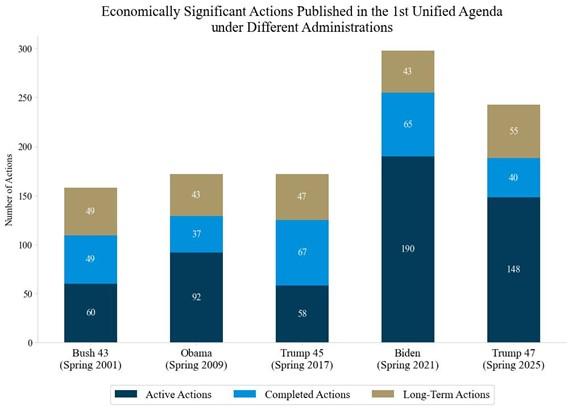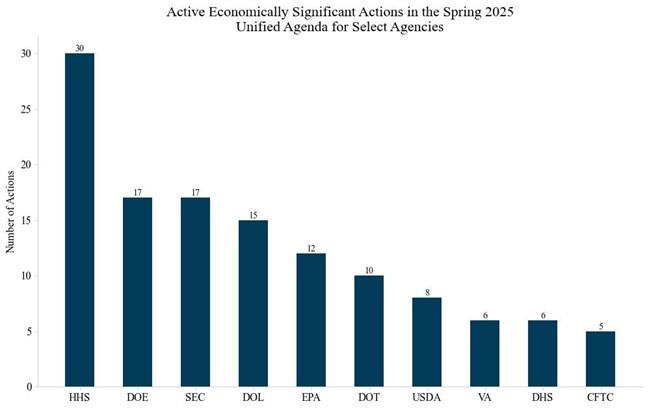Download this commentary (PDF)
In brief...
This commentary analyzes the Spring 2025 Unified Agenda, which is the first Unified Agenda of the second Trump administration. It covers rulemaking highlights from the Agenda and identifies emerging regulatory and deregulatory trends in the new administration.
Introduction
After months of anticipation, the Office of Information and Regulatory Affairs issued the Spring 2025 Unified Agenda on September 4. In the Unified Agenda, federal agencies outline their active, long-term, and completed regulatory actions. Agencies publicly disclose the topics under consideration for rulemaking activity in the Unified Agenda, offering a first public look behind the scenes at the agencies’ near-term and long-term priorities. As the first Unified Agenda of the second Trump administration, this Agenda features hundreds of new items that align with the president’s deregulatory program.
What's in the Spring 2025 Unified Agenda?
The Spring 2025 Unified Agenda contains 3,816 agency actions. Of these, 243 are “economically significant”—meaning the actions are likely to have an annual economic effect of $100 million or more (Table 1). The Agenda categorizes agency actions into stages: “active” actions are rules in the pre-rule, proposed rule, or final rule stage that the agency anticipates acting on within the next 12 months. “Long-term” actions are items that the agency anticipates action beyond the next 12 months. “Completed” actions are finalized or withdrawn rules. By stage, this Unified Agenda lists 2,099 active actions, 807 long-term actions, and 910 completed actions.
Table 1. Overview of the Spring 2025 Unified Agenda
Stage | All Agency Actions | Econ. Significant Actions | First Time Published |
Active | 2,099 | 148 | 865 |
Long-term | 807 | 55 | 182 |
Completed | 910 | 40 | 110 |
Total | 3,816 | 243 | 1,157 |
As the first Unified Agenda following the presidential transition, some of the completed economically significant actions are withdrawals of notable Biden-era rules. Among the withdrawals are two energy efficiency rules from the Department of Energy that would have regulated commercial refrigerators, freezers, and refrigerator-freezers and water heaters. Three others are rules that the Food and Drug Administration (FDA) has slated withdrawals for three proposed tobacco regulations: one regulating nicotine yield in cigarettes, one prohibiting menthol cigarettes, and a third that would prohibit characterizing flavors in cigars other than tobacco.
At 243 economically significant actions, this Unified Agenda contains 55 fewer economically significant actions than the Biden administration’s first Unified Agenda (Figure 1). However, it contains many more of these actions than the first Unified Agendas from the Bush, Obama, and first Trump administrations. The substantial number of economically significant actions—particularly active and long-term—lays the groundwork for the administration’s deregulatory agenda both in the short term and long term. Despite being deregulatory, these actions are listed in the Unified Agenda because the government must undergo another rulemaking process to change or remove a final rule.
Figure 1.

More than twice as many actions in the Spring 2025 Agenda are designated as “first time published” (in the Unified Agenda) than in Biden’s Spring 2021 Agenda (Table 2). That many of the current administration’s actions are new to the agenda could indicate that the administration is charting a new, distinctive course, rather than continuing where the prior administration left off.
Table 2. “First Time Published” Actions as a Share of All Actions
Stage | Biden (Spring 2021) | Trump 47 (Spring 2025) |
Active | 24.0% | 41.2% |
Long-term | 11.6% | 13.6% |
Completed | 9.9% | 20.0% |
Total | 19.2% | 30.3% |
Focusing only on active significant actions, the Spring 2025 Agenda includes more economically significant actions than the Bush, Obama, and Trump 45 administrations’ first Agendas, but fewer “other significant” actions[1] than the Obama and Biden administrations’ first Agendas (Figure 2).
Figure 2.

One key change this year is how independent regulatory agencies’ actions are categorized: While independent regulatory agencies have always been included in the Unified Agenda, actions from those agencies are newly categorized as “economically significant” in this Agenda as a result of Executive Order (EO) 14215, “Ensuring Accountability for All Agencies.” That order expanded the regulatory analysis requirements in EO 12866 to independent regulatory agencies.
To compare more directly to previous administrations, I excluded independent regulatory agencies’ actions from the count of economically significant actions.[2] Even after removing these agencies from the total, the Spring 2025 Agenda still contains more active economically significant actions than the Bush, Obama, and Trump 45 administrations, though fewer than Biden.
Active Economically Significant Regulations by Agency
Examining the active economically significant actions by agency offers an indication of the administration’s near-term regulatory priorities. The ten agencies with the highest number of active economically significant actions include the Department of Health and Human Services (HHS), the Department of Energy (DOE), the Securities and Exchange Commission (SEC), the Department of Labor (DOL), the Environmental Protection Agency (EPA), the Department of Transportation (DOT), the Department of Agriculture (USDA), the Department of Homeland Security (DHS), the Department of Veterans Affairs (VA), and the Commodity Futures Trading Commission (CFTC), shown in Figure 3. All of these agencies together account for 126 of the Agenda’s 148 active economically significant actions—over 85 percent.
Figure 3.

The inclusion of SEC and CFTC on this list is a result of EO 14215’s extension of EO 12866 regulatory review requirements to independent agencies.
HHS is working on the largest number of active economically significant actions at the moment. Of the 30 actions, 10 are published for the first time in this Unified Agenda and are anticipated between September and the end of this year. FDA anticipates rescinding regulations on laboratory-developed medical tests in September, as well as a proposed rule to amend substances generally recognized as safe food substance regulations in October. The Centers for Medicare and Medicaid Services (CMS) intends to issue a final rule that will remove a restriction that limited states’ ability to use immigration status to determine state residency for Medicaid and Children’s Health Insurance Program eligibility. CMS also intends to issue an advance notice of proposed rulemaking (ANPRM) regarding incentives and requirements for Medicare providers to use American-made personal protective equipment.
DOE included 17 active economically significant actions in the Spring 2025 Agenda, 16 of which are published for the first time. Of those first-time published regulations, 14 are notices of proposed rulemaking (NPRM) that DOE issued in May that appear to rescind existing energy efficiency standards. DOE also includes a new NPRM on zero-based regulating pursuant to EO 14270, “Zero-Based Regulatory Budgeting to Unleash American Energy,” which the agency anticipated releasing in July 2025.
SEC published 15 new actively economically significant actions for the first time and two previously published actions in this iteration of the Unified Agenda. SEC anticipates publishing two ANPRMs in October: one addressing potential changes to the registration and disclosure of asset-backed securities, and another on the effectiveness of the consolidated audit trail. Other actions, anticipated in April 2026, include NPRMs on crypto assets and market structures, among other topics.
DOL included 15 active economically significant actions, 10 of which are new to the Unified Agenda. One action, anticipated August 2025, would rescind regulations increasing the minimum wage for federal contractors.
EPA’s eight “first time published” actions—out of 12 total active economically significant actions—highlight the new administration’s dramatic shift in environmental priorities. Two actions published as NPRMs in June propose rollbacks on greenhouse gas emissions standards for fossil fuel fired electric generating units (EGUs) and hazardous air pollutants standards for coal- and oil-fired EGUs. The Agenda also foreshadows NPRMs that would propose reconsidering the greenhouse gas endangerment finding and related regulations of motor vehicle emissions and airplane pollution.
DOT included 10 active economically significant actions, two of which are new to the Agenda. DOT expects to issue a NPRM reconsidering the Corporate Average Fuel Economy Standards later in September. The agency also includes a plan to increase flexibility on disclosure of airline ancillary fees, which it intends to issue as a NPRM in March.
USDA is working on eight active economically significant regulations, six of which are making their first appearance in the Unified Agenda. The agency issued an interim final rule earlier this year amending its National Environmental Policy Act (NEPA) regulations in response to the Council of Environmental Quality rescinding its NEPA implementing regulations. Looking forward, USDA identified plans to limit who qualifies for the Supplemental Nutrition Assistance Program through categorical eligibility.
DHS identified six active economically significant actions; five of them were published for the first time in this Agenda. These proposals include changes to student visa durations, which was published in the Federal Register in August; employment authorization for asylum applicants and other populations, both of which DHS expected to publish in August 2025; and introducing weighted selection to the H-1B visa process, also expected in August. The latter three actions have not yet been published.
All of the active economically significant actions from the VA and the CFTC have been included in past Agendas, although CFTC’s actions are newly reclassified as economically significant due to EO 14215.
Conclusion
The Spring 2025 Unified Agenda shows that the second Trump administration has significant deregulatory plans across a variety of agencies. The number of new actions in this Agenda indicates that agencies have already started working towards these efforts.
Going forward, the Unified Agenda will likely include additional information about a rule’s regulatory or deregulatory status as a result of EO 14192, “Unleashing Prosperity Through Deregulation.” This order created a 10-in, 1-out regulatory budgeting rule similar to the first Trump administration’s 2-for-1 rule. Some rules in this Agenda already featured an EO 14192 designation stating if the rule was regulatory or deregulatory. The Spring 2025 Unified Agenda guidance indicated that the Fall 2025 Agenda guidance will include more detailed instructions for this designation. That instruction also suggests that the administration will still release a Fall 2025 Agenda, although likely on a delayed schedule.
[1] For this analysis, I excluded the Commodity Futures Trading Commission, the Federal Deposit Insurance Corporation, the Federal Energy Regulatory Commission, the Federal Reserve, the Federal Trade Commission, the Nuclear Regulatory Commission, the Pension Benefit Guaranty Corporation, and the Securities and Exchange Commission. Collectively, these agencies include 32 economically significant active actions in the Spring 2025 Unified Agenda.
[2] EO 12866 defines significant regulations in Section 3(f). Economically significant regulations are likely to have an annual effect on the economy of $100 million or more. “Other significant” regulations include regulations that would create inconsistency between agencies; would materially alter the budget impacts of entitlements and grants; or that raise novel legal or policy issues.

